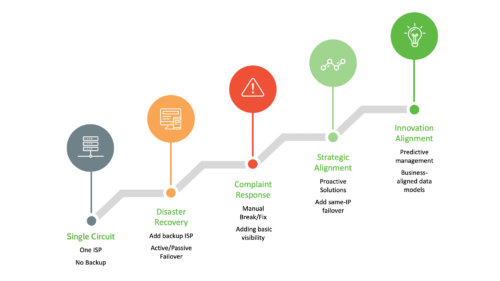
Small and mid-sized businesses (SMBs) spend almost $200 billion per year on new digital and cloud technologies, to improve efficiency, accelerate growth, and enhance employee and customer experience. For these businesses, internet connectivity is no longer a “best-effort” utility. It’s now a strategic business imperative.
Fortunately, the SMB IT community is stepping up their game with a whole new approach to internet connectivity, with new strategies and technologies that deliver the internet performance and reliability their businesses need now.
Bigleaf Networks designed the Internet Maturity Model as a guide for SMBs that need to deliver new levels of internet performance and reliability for their own users. The model describes four stages of maturity that align with the needs of the SMB and support increased adoption of digital and cloud technologies.
Each stage represents a tradeoff among cost, reliability, and speed factors—enabling SMBs to find the right balance.


Stage 0: Single circuit
Let’s assume that every business reading this article has an internet connection. So, we debated whether to include single-circuit arrangements as part of the maturity model. It might be like saying that learning to walk is the first step in becoming an Olympic athlete. In other words, not a helpful or meaningful use of time. (Note: If you feel differently, let us know! We’re always looking to improve the model.)
Still, most folks we talk to have at least a passive backup. So, we’re going to start the official maturity model with…

Stage 1: Basic disaster recovery
Almost every business today relies on an Internet connection to operate some part of their business: phones, Zoom, MS Teams, CRM, etc. So, they need some way to keep running when major outages hit. The most basic way to provide this is Stage 1: Basic disaster recovery.
In this stage, the business has installed a second internet connection, preferably through a different provider and medium, that can be used when the primary is down for extended periods of time. That second circuit is typically integrated using a firewall or router that uses a ping to determine when the primary connection goes down, and that up/down monitoring issues an alert when there’s an outage. When an outage lasts long enough, all business traffic is moved, either manually or automatically, to the backup circuit.
The benefit of this approach is its simplicity and relatively low cost. The business likely has a firewall in place to manage the failover, and low-cost backups are widely available in most markets. But that simplicity comes at a cost.
Basic failover occurs only when the internet is completely down. But poor performance, brownouts and mini-outages continue to disrupt business connectivity even more often than full outages. And when failover does occur, all IP-specific traffic and services need to be reconnected using the IP address of the backup circuit. This can be a time-consuming process sometimes. Plus, the business has to constantly pay for an internet connection that it hopes never to use.
Stage 1 is ideal for businesses that are okay with several internet disruptions per month and just need to know that they won’t be down for days at a time. When users start complaining about performance-related issues that failover can’t solve, IT or the MSP go to work and move on to…

Stage 2: Complaint response
At some point, regular internet disruptions start becoming regular business disruptions. When that happens, IT starts hearing complaints. Sales and support complain that their calls are dropping or choppy. Management complains that video conferences are constantly cutting in and out. Critical SaaS applications like CRM, ERP, and collaboration tools just don’t work as well as they should. IT needs to respond, leading to a stage we call “complaint response.”
Companies in the complaint response stage know that users are unhappy. They know it needs to be fixed. And they feel responsible to solve it themselves.
So internal IT teams or MSPs set to work, with mostly manual tools and their own effort. They dig into the traditional toolbox—SNMP, PRTG, Zabbix, Graphana (for graphing data), Graylog, Netflow/sFlow tools, etc…
Complaint response also involves a fair amount of time talking to vendor and ISP support teams to find out if the issues originate on their end. More advanced teams might even use their own automated traceroute, MTR, or other hop-by-hop network tools to find issues along the path.
With enough work, the complaint-response approach can usually narrow down the potential issues. It might even lead to some best-guess solutions that can reduce the likelihood of complaints, like upgrading ISPs, implementing more advanced traffic handling in the firewall.
Ultimately, though, these solutions rely on manual response before issues can be addressed. As a result, performance and outage issues continue to recur.
Stage 2 may work for companies that can deal with regular, but shorter, disruptions and that have enough IT staff time available to monitor and react to issues. Once the business impact of these regular issues can impact productivity and customer experience, IT and MSPs need to get proactive and embrace…

Stage 3: Strategic alignment
Stage 3 is when we at Bigleaf typically meet folks on their journey.
Sometimes IT or the MSP proactively embrace strategic alignment before deploying a new technology, like VoIP phones, SaaS-based ERP/CRM, or a new cloud-based call center. More often than not, though, businesses are pushed into Stage 3 after spending way too long dealing with complaints in Stage 2.
When the Stage 2 reactive approach falls short, pressure starts building from the C-suite. Sales teams can’t make calls, support teams can’t keep customers happy, entire call centers are down for minutes at a time, doctors can’t access patient records. The moment that business managers can attribute poor team performance to poor internet performance, the company’s internet becomes a strategic imperative. “Good enough” just isn’t good enough anymore. So, IT starts getting out ahead of the problem in Stage 3: strategic alignment.
By the time a business gets to Stage 3, IT or the MSP has usually tried the standard fixes already—more bandwidth, failover, firewall-based tools. Now they’re exploring new ideas and technologies.
This stage starts with a deep dive into the business’ needs. Which applications/technologies are most important? What kind of uptime/reliability does the business need? What are they willing to spend to get it? For many businesses, the internet connection has been seen as a simple utility up to this point. Many realize that they’re severely underspending on connectivity relative to its importance to the business. That opens the door to options IT may not have considered.
For context, the average internet disruption costs a small to midsize company $137 to $427 per minute according to a recent “cost of downtime” study by IDC for Carbonite. That study also indicated that downtime costs ranged between $82,200 and $256,000 for a single incident. Compared with that, an extra $6k-$12k per year site for reliable internet infrastructure is an easy ROI calculation.
With additional budget approved, IT or the MSP needs a way to see and control the business’ entire internet footprint across all their ISPs and applications. Traditionally, they may have used disparate tools to accomplish this. More recently, third-party overlay platforms like Bigleaf allow for this level of visibility and control from a single platform.
Regardless of which approach you choose, this platform should ideally be able to move traffic between circuits without changing the IP address so calls and other session-based traffic won’t drop when moving between circuits. It will also need a backbone network that can manage your traffic across the entire internet path.
Next, that platform has to be configured. Different kinds of traffic need to be identified, prioritized and load-balanced between your different internet circuits. This can be done manually with policies in more traditional systems. But most companies we work with at this stage prefer an automated system that uses AI to detect and resolve issues. By leveraging the AI instead of manual policies, the system can reconfigure on the fly to adapt to any new applications or circuit issues. This means almost no disruptions with almost no work needed, a real win-win.
Stage 3 is where most businesses who rely on internet-based technologies should be. At this point, IT is providing true 99.99% performant uptime. Where AI is used, that uptime is maintained without any additional work no matter what new technologies are deployed. Frankly, what else could a business want?
I’m glad you asked…

Stage 4: Innovation alignment
Once businesses have the reliability and performance of Stage 3, they often start innovating faster and more frequently. With reliable connectivity, the barrier to adoption for new cloud and internet-based technologies drops considerably. This speed and innovation can be a huge competitive advantage for a small or medium-sized business, but it means that IT needs to get farther ahead of the connectivity needs.
Stage 4 is about ensuring that connectivity never slows down innovation. When IT reaches “innovation alignment,” they’re using data to predict the needs of the business 6-18 months in the future so that updates can be made before their needed.
To do this, IT must start using their available data to build predictive models. For instance, if the historical throughput of voice/video data per user is known, IT can use that data to add the appropriate capacity when hiring a new sales team. If the business wants to deploy a new interactive collaboration tool for their remote offices, they can look back at that office’s performance metrics to determine if a higher-quality or additional circuit is required.
At this point, a business may also hire full-time staff to manage internet operations, or at least make it an official part of someone’s job.
For many businesses, this innovation alignment is still aspirational. But getting there can have a dramatic impact on the speed of innovation. Ultimately, isn’t that what the internet is for?
Find the right internet maturity model for your business
There’s no question that you’ll spend more on your internet connectivity as you move up the internet maturity path. Even though most businesses want to deliver Stage 3-level reliability, they’re stuck asking “is it worth it?” Bigleaf’s team has worked with thousands of SMBs to answer that very question, and more and more of them are saying “yes!”
Today’s SMBs rely more on their internet connectivity than ever. If you’re looking to move up the internet maturity path, or if you’re just curious about what the next stage might look like for your business, request a 30-minute assessment today. Bigleaf Networks is here to help.







